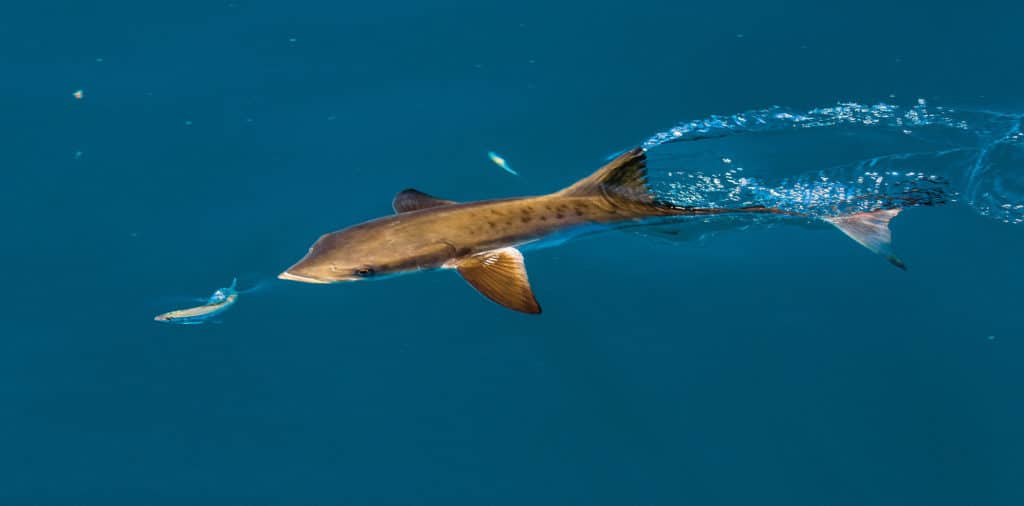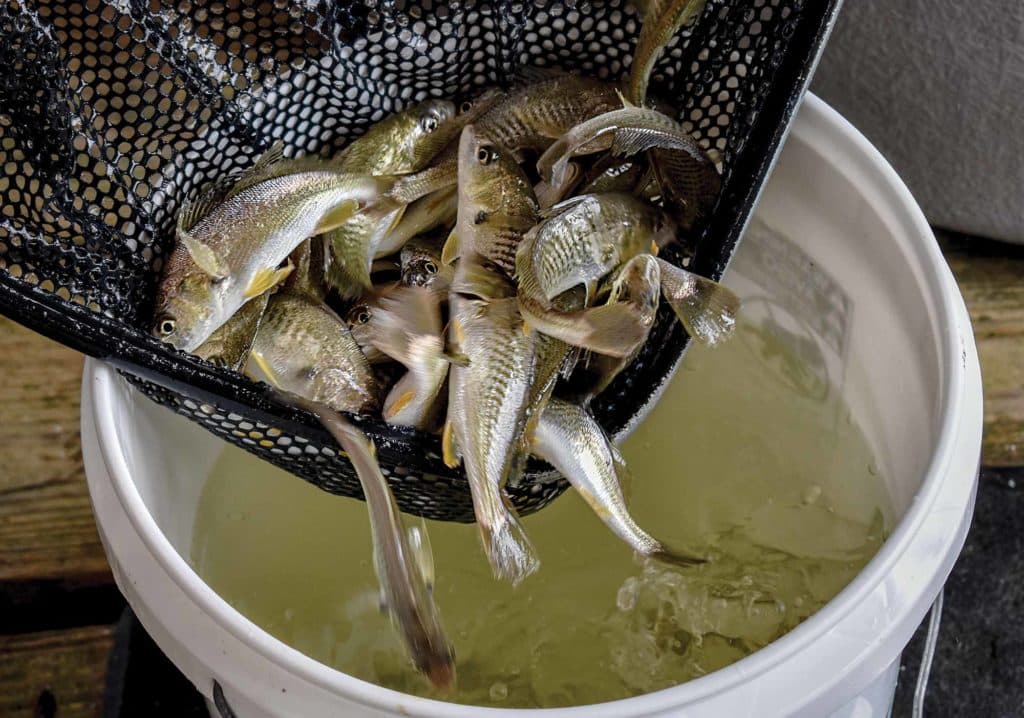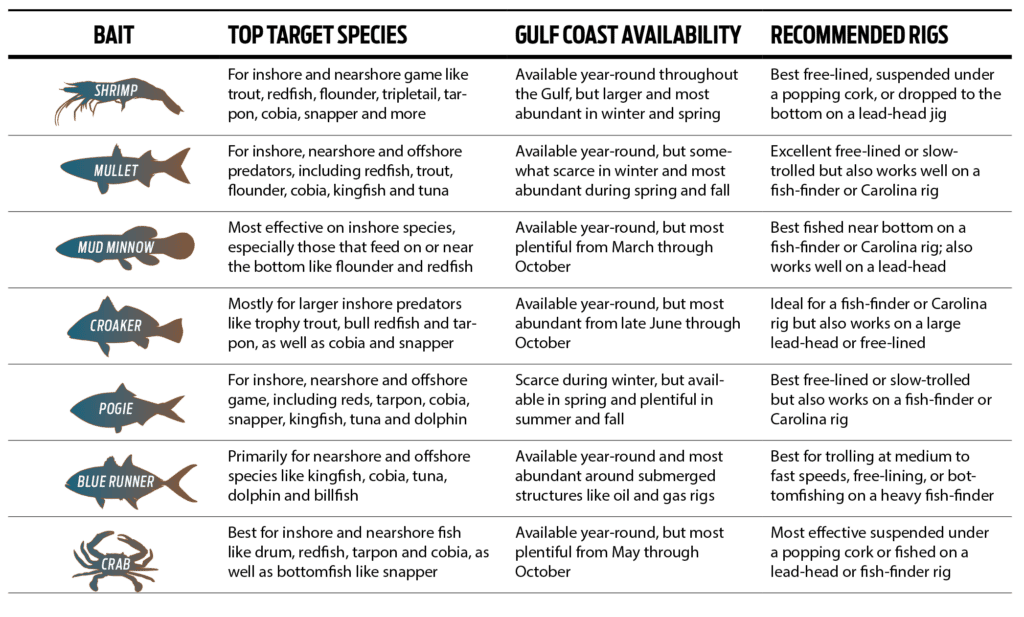
Along the Gulf Coast, all the sought-after species, from speckled trout and redfish to kingfish, cobia and tuna, zero in on liveys.
Crustacean Sensation
In Gulf of Mexico waters, everything eats shrimp. You definitely don’t want to come back as one, if there is such a thing as reincarnation. While shrimp certainly appeal to inshore species, they’re also effective on larger game well away from shore. I’ve used big shrimp to catch red snapper, amberjack, dorado, tarpon, kings and cobia.
Free-lining is one of the most effective ways to fish live shrimp, especially around jetties. The trick is in the rigging. Tie on a No. 2 treble hook, run one point through the shrimp’s head (under the horn, in front of the dark spot), or hook the bait through the tail, then pinch on the line — about a foot above the hook — a split shot heavy enough to get the shrimp down the water column to where the trout and reds are feeding. This same tactic has caught some pretty healthy tarpon along the Port O’Connor jetties on the middle Texas coast.
Another effective tactic is fishing a shrimp, hooked through the tail, on a ⅛- to ¼-ounce lead-head jig. The fact that you can jig it over and around structure at various depths, regardless of how strong the current is moving, makes it deadly around shell reefs, wrecks, and offshore oil and gas platforms.

Baitfish Inshore
Speaking of deadly, a live croaker fished over a reef, at the jetties, or in the surf is an absolute killer for trout and reds. Croakers are sold by the dozens at bait camps along the Texas coast from about June through October. The best way to rig one is with a No. 3 to No. 6 Kahle or croaker hook on an 18-inch section of fluorocarbon leader. Tie one end of the leader to the hook and the other to a black barrel swivel. Then run braided line through a slip weight and tie it to the swivel. A lot of fishermen like to also add a rattle between the weight and the swivel, a trick that’ll get the attention of reds and trout in a hurry, even in murky water.
Flounder are suckers for finger mullet and mud minnows. A Carolina rig is one of the all-time favorites for catching these bottom huggers, which bite softly and slowly. When a flounder eats a livey, it’s important that it doesn’t feel tension; otherwise, it will likely spit out the bait.

Shrimp Free-Line Rigs
2. Uni- or clinch knot
3. No. 2 treble hook under horn
4. Avoid dark spot Steve Sanford

2. Uni- or clinch knot
3. Split shot Pinch a split shot (weight based on current) onto the leader, a foot above the bait, to keep the shrimp closer to the bottom, where predators like redfish, trout, black drum and flounder wait in ambush. Steve Sanford
Offshore Choices
Live baits are a must for offshore fishing in the Gulf. Fishing live shrimp and croakers along offshore weed lines for dorado, cobia and wahoo is an outright blast. The drill is simple: The person at the helm, preferably from an elevated vantage point, spots the fish and tells the anglers where to cast their liveys.
Another excellent bait for cobia as well as king mackerel is pogies (menhaden). And blue runners, aka hardtails, are an outstanding choice for yellowfin tuna and blue marlin. Longtime offshore guide Jerry Allen is one of the best at catching big game out of Venice, Louisiana, and he likes both options.

Live-Bait Carolina Rig
2. Swivel
3. Uni-knot or clinch knot
4. Uni-knot or non-slip loop knot
5. No. 3 to No. 6 Kahle or croaker hook
6. Mud minnow (aka cocahoe or killifish) Steve Sanford

Weedless Live-Bait Trolling Rig
2. Girth hitch a clear vinyl rubber band to the hook eye and stretch it to the barb
3. In-line circle or live-bait hook (sized to match bait)
4. Menhaden (aka pogie) Many anglers live and die with lures, but it’s a fact that live baits generally deliver more bites inshore and off. Steve Sanford
Size Matters
“There are days when the size of a live bait makes a big difference,” says Allen. “For marlin, a foot-long hardtail is perfect. That’s when you want to bridle a couple and bump-troll them along a rip or around a deepwater rig. In real-clear water, a small pogie, about 5 inches long, can be deadly on yellowfin tuna. We were out one day and the bite was slow for everybody. But we could see tuna busting bait on the surface. I switched from a big hardtail to a small pogie and immediately hooked up with a 198-pounder. The other boats couldn’t figure out what we were doing.”
Allen also likes to downsize his live-bait leader for yellowfins in really clear water. “I’ll drop down from a 60-pound to 30-pound fluorocarbon leader. I’ll snell the 6/0 hook to an 18-foot leader, then use an uni-to-uni to join the leader to 80-pound braid. That rig is bulletproof.”

Live-Bait Chumming
Another excellent tactic when live-baiting for tuna is to chum with hardtails and pogies. One of the best chumming devices is a plastic whiffle-ball bat with the top of the barrel cut off. You can load it with fresh live baits and sling them way out, away from the boat. That’s also a good tactic when fishing for speckled trout in the surf or over a reef.
“You talk about exciting fishing, try live-bait chumming for big yellowfins,” says Allen. “They will rocket out of the water when feeding on the chum. That’s when you can bump-troll through them and get some incredible hits, not only from the tuna but also wahoo and the occasional marlin.”









